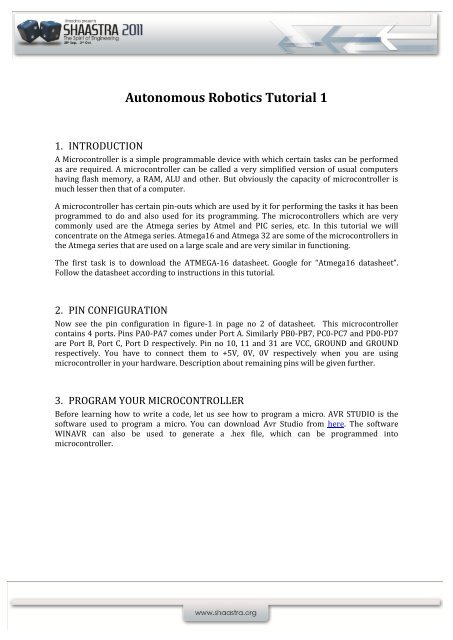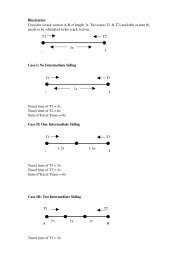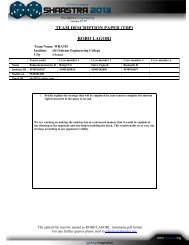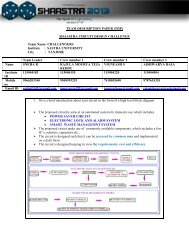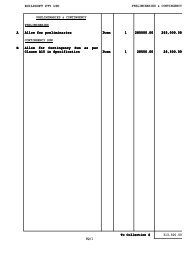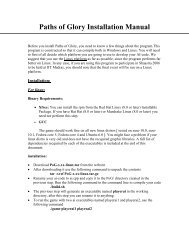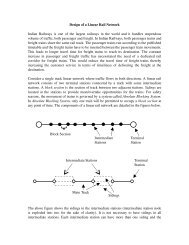Basic Microcontroller Programming - Shaastra
Basic Microcontroller Programming - Shaastra
Basic Microcontroller Programming - Shaastra
You also want an ePaper? Increase the reach of your titles
YUMPU automatically turns print PDFs into web optimized ePapers that Google loves.
Autonomous Robotics Tutorial 1<br />
1. INTRODUCTION<br />
A <strong>Microcontroller</strong> is a simple programmable device with which certain tasks can be performed<br />
as are required. A microcontroller can be called a very simplified version of usual computers<br />
having flash memory, a RAM, ALU and other. But obviously the capacity of microcontroller is<br />
much lesser then that of a computer.<br />
A microcontroller has certain pin-outs which are used by it for performing the tasks it has been<br />
programmed to do and also used for its programming. The microcontrollers which are very<br />
commonly used are the Atmega series by Atmel and PIC series, etc. In this tutorial we will<br />
concentrate on the Atmega series. Atmega16 and Atmega 32 are some of the microcontrollers in<br />
the Atmega series that are used on a large scale and are very similar in functioning.<br />
The first task is to download the ATMEGA-16 datasheet. Google for “Atmega16 datasheet”.<br />
Follow the datasheet according to instructions in this tutorial.<br />
2. PIN CONFIGURATION<br />
Now see the pin configuration in figure-1 in page no 2 of datasheet. This microcontroller<br />
contains 4 ports. Pins PA0-PA7 comes under Port A. Similarly PB0-PB7, PC0-PC7 and PD0-PD7<br />
are Port B, Port C, Port D respectively. Pin no 10, 11 and 31 are VCC, GROUND and GROUND<br />
respectively. You have to connect them to +5V, 0V, 0V respectively when you are using<br />
microcontroller in your hardware. Description about remaining pins will be given further.<br />
3. PROGRAM YOUR MICROCONTROLLER<br />
Before learning how to write a code, let us see how to program a micro. AVR STUDIO is the<br />
software used to program a micro. You can download Avr Studio from here. The software<br />
WINAVR can also be used to generate a .hex file, which can be programmed into<br />
microcontroller.
4. AVR STUDIO:<br />
Open AVR studio after installation. You will see a window like this.<br />
Select New project option and move further. You will see the window below.<br />
Create a folder with your project name in your comp.<br />
Select AVR GCC under project type. Name your project in project name column. Give the<br />
destination address for project folder you created in location column and click next. The next<br />
window is as shown below.
Select AVR simulator under debug platform. Select the micro-controller you are using under<br />
device column. I am using ATMEGA 16 so I selected it. Now click on finish option.<br />
Next window is as follows.<br />
Enter your code in the dialogue box at centre. Once the code is done, click on “build” in the<br />
toolbar on the top. Now the hex code will be saved in the default sub-folder of the created folder.<br />
Try it with sample code given below. Paste it in the dialogue box and click on build.<br />
And look for the hex file generated in the folder. This code is used to blink LED'S.<br />
#include <br />
#include <br />
main()<br />
{<br />
DDRA=0xFF;<br />
while(1)<br />
{<br />
PORTA=0b00000000;<br />
_delay_ms(1000);<br />
PORTA=0b11111111;<br />
_delay_ms(1000);<br />
}<br />
}<br />
5. WRITING THE CODE<br />
Now let's see how to write a code.<br />
5.1. Defining Directions<br />
Out of 40 pins on micro 32 pins (Pins in ports A, B, C, D) can be as input or output pins as<br />
defined by the user. User has the comfort of defining any pin as an input or output pin. So in the<br />
beginning of the code you have to define input and output pins as follows:<br />
For example I want to define Port A as input and Ports B, C, D as outputs I will do it as follows:<br />
DDRA=0b00000000 //All pins of port A defined as inputs.<br />
DDRB=0b11111111<br />
DDRC=0b11111111<br />
DDRD=0b11111111 //All pins of ports B, C, D defined as outputs.
In the above commands DDRA means you are calling port A to define.'0b' stands for binary<br />
information. The first zero after '0b' indicates PA7 while the last zero indicates PA0.<br />
Example:<br />
Suppose you want to define PA0-PA3 as input and PA4-PA7 as output, what will you write?<br />
It’s pretty simple. You will write<br />
DDRA=0b11110000.<br />
5.2. Reading inputs and giving outputs<br />
Now let's assume you want the micro to give 5V output at some of the pins in PORTA when<br />
some of the pins in PORTB are given a voltage of 5V (i.e. a logical high or 1). The first thing to do<br />
is obviously to define PORTA as output port and PORTB as input port as was explained in the<br />
previous part. The next part of the code is as follows:<br />
if (PINB==0b00000101)<br />
{<br />
PORTA=0b10101010;<br />
}<br />
else{}<br />
By this command you are asking the micro to read inputs from 'B' and check whether it is equal<br />
to 0b00000101 and if yes, then give output at 'A' as 0b10101010 i.e. PA7, PA5, PA3 and PA1 will<br />
read 5V if checked with a multimeter. So for reading data we have to use PIN command and for<br />
setting outputs we have to use PORT command.<br />
Now let's take up small code as an example and understand it.<br />
#include
when we use sensors.<br />
5.3.2. _delay_ms(1000) command is used to freeze the state of micro. You have to include the<br />
library util/delay.h for using it.<br />
5.3.3. Observe the usage of PORT and DDR commands.<br />
5.3.4. In defining input 0xFF is used. 0x implies that the information following it is in<br />
hexadecimal format and FF stands for 11111111 in binary. Thus it is an equivalent of<br />
0b11111111<br />
5.3.5. The code is included in an infinite loop by using “while”. Just think over it once.<br />
5.4. Example<br />
Blink 4 LED'S in a row such that only one of them switches on while remaining is switched off.<br />
Solution:<br />
#include <br />
#include <br />
main()<br />
{<br />
DDRA=0xFF;<br />
while(1)<br />
{<br />
PORTA=0b00000001;<br />
_delay_ms(500);<br />
PORTA=0b00000010;<br />
_delay_ms(500);<br />
PORTA=0b00000100;<br />
_delay_ms(500);<br />
PORTA=0b00001000;<br />
_delay_ms(500);<br />
}<br />
}


